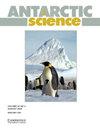南极半岛地区和地方空间尺度上的生境严重性特征结构土壤群落
IF 2
4区 地球科学
Q3 ENVIRONMENTAL SCIENCES
引用次数: 1
摘要
摘要南极土壤提供了一个很好的环境,可以在空间和环境尺度上测试生物地理模式,因为它们的群落相对简单,并且物理因素占主导地位,形成了强烈的环境梯度。在快速变化的环境中,它们独特的陆地群落是保护工作的主题,这一事实也带来了额外的紧迫性。我们调查了南极洲海洋地区和地方尺度上土壤群落组合、α和β多样性与气候和环境参数的关系。我们从栖息地严重程度不同的区域梯度进行采样,从相对有利到更恶劣的物理化学条件不等。在区域范围内,细菌群落特征和微丝足类丰度沿着这一严重程度梯度变化,但大多数真菌群落指标没有变化。微型节肢动物和微生物群落在土壤和气候参数最具影响力方面存在差异,影响每个分类单元的具体参数在广阔和精细的空间尺度上也存在差异。这表明,保护工作需要关注各种各样的栖息地特征,才能成功地涵盖不同分类群的多样性。由于贝塔多样性是物种更替的结果,保护工作也不能只关注生物多样性最强的地点,以有效保护生物多样性的各个方面。本文章由计算机程序翻译,如有差异,请以英文原文为准。
Habitat severity characteristics structure soil communities at regional and local spatial scales along the Antarctica Peninsula
Abstract Antarctic soils provide an excellent setting to test biogeographical patterns across spatial and environmental scales given their relatively simple communities and the dominance of physical factors that create strong environmental gradients. Additional urgency is given by the fact that their unique terrestrial communities are the subject of conservation efforts in a rapidly changing environment. We investigated relationships of soil community assembly and alpha and beta diversity with climatic and environmental parameters across regional and local scales in Maritime Antarctica. We sampled from a regional gradient of sites that differ in habitat severity, ranging from relatively favourable to harsher physicochemical conditions. At the regional scale, bacterial community characteristics and microarthropod abundance varied along this severity gradient, but most measures of fungal communities did not. Microarthropod and microbial communities differed in which soil and climate parameters were most influential, and the specific parameters that influenced each taxon differed across broad and fine spatial scales. This suggests that conservation efforts will need to focus on a large variety of habitat characteristics to successfully encompass diversity across taxa. Because beta diversity was the result of species turnover, conservation efforts also cannot focus on only the most biodiverse sites to effectively preserve all aspects of biodiversity.
求助全文
通过发布文献求助,成功后即可免费获取论文全文。
去求助
来源期刊

Antarctic Science
地学-地球科学综合
CiteScore
3.60
自引率
6.20%
发文量
42
审稿时长
3 months
期刊介绍:
Antarctic Science provides a truly international forum for the broad spread of studies that increasingly characterise scientific research in the Antarctic. Whilst emphasising interdisciplinary work, the journal publishes papers from environmental management to biodiversity, from volcanoes to icebergs, and from oceanography to the upper atmosphere. No other journal covers such a wide range of Antarctic scientific studies. The journal attracts papers from all countries currently undertaking Antarctic research. It publishes both review and data papers with no limits on length, two-page short notes on technical developments and recent discoveries, and book reviews. These, together with an editorial discussing broader aspects of science, provide a rich and varied mixture of items to interest researchers in all areas of science. There are no page charges, or charges for colour, to authors publishing in the Journal. One issue each year is normally devoted to a specific theme or papers from a major meeting.
 求助内容:
求助内容: 应助结果提醒方式:
应助结果提醒方式:


